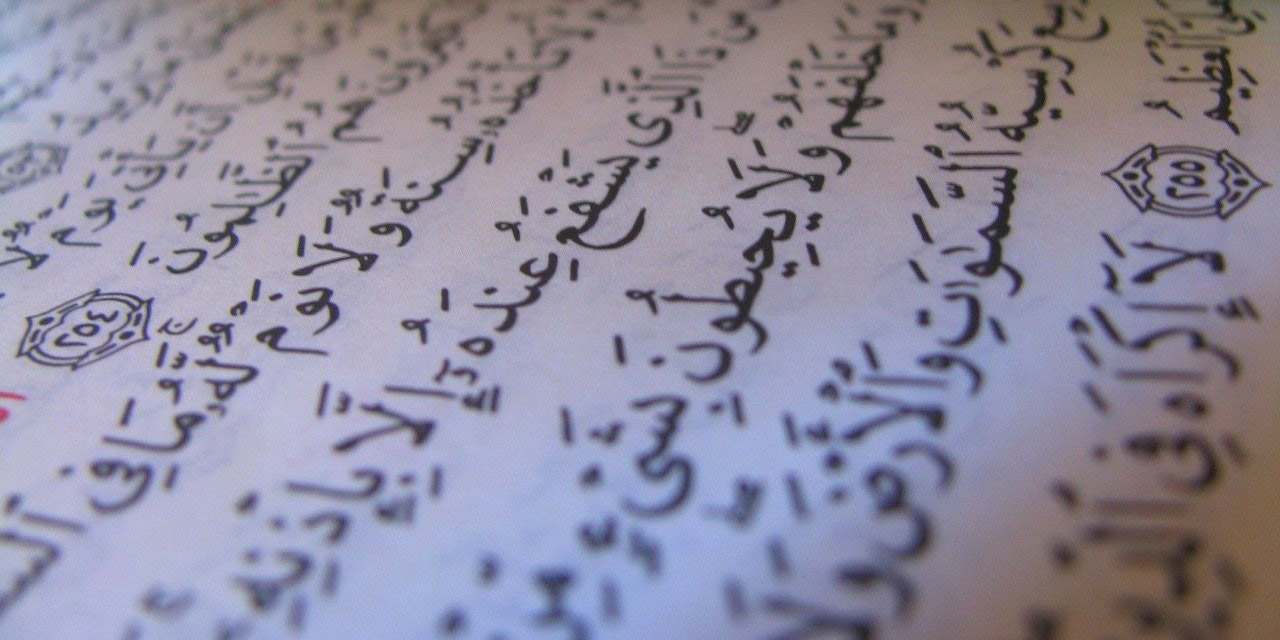
IS THE QURAN ‘PURE’ ARABIC?
The following piece was commissioned by a research group looking into the linguistic origins of the Qur’an, with particular focus on claims of it containing “a pure Arabic”. This was part of a series of independently researched and written essays.
An Insight into Linguistic Borrowing and Nativization
Nestled deep in an underground chamber used by Pueblo Indians for religious rites, American anthropologist Frank Hamilton Cushing invites the wrath of a Whipper Kachina. Whipper Kachinas are guards – masked members of the tribe – who guard ritual performances and punish those not behaving in accordance with the rules.
Cushing was well aware of the prominence of Kiva speech – indeed decades of work on the Arizona Tewa tribe meant he was well acquainted with the speech performed in religious chambers when sacred ceremonial altars were erected. Still, a momentary lapse invited the swift strike of a yucca whip: he had used a Spanish word in a Zuni kiva (ceremony) and the tribe called for his purification from this misdemeanour. After his whipping, Cushing was instructed to say the Zuni equivalent of ‘thank you’. During ritual performance, there is an explicit and enforced proscription against the use of foreign words and/or native vocabulary. Innovation is neither desired nor tolerated. As Pueblo Indians, the Zuni are paragons of what Joel Sherzer termed ‘linguistic conservatism’[1] – that is, the celebrated penchant for resistance to linguistic borrowing.
And so it is, language purity is championed, strived for, protected at all costs. How pure can purity be? How is it possible for language – a living and ever-changing vehicle for communication – to even boldly claim such a thing as ‘purity’ and ‘non contamination’ from other languages?
The Qur’ān – a scripture believed to be the literal Word of God – claims to be a book comprised of a ‘pure Arabic’ – a language made ‘easy’ for still being accessible to those wishing to study the original language of revelation. However, of the many self-referential claims made in the Qur’ān, the scripture being ʿarabiyyun mubīn (clear Arabic)[2] has been one which has attracted much criticism. As the linguistic conservatives of the Zuni tribe required of Cushing, how does one explain words of foreign-language (i.e.: non Arabic) origin used in the Divine book?
This essay intends to explore this claim of a ‘pure Arabic’ Qur’ān, offer insights into the historical context of these claims and how this apparent contradiction is reconciled within Islamic thought.
Divergent Opinions
As with many areas of intellectual inquiry, traditional Islamic scholarship has always included a spectrum of – sometimes – diverging opinions; the topic of foreign words in the Qur’ān is no exception to this. Whilst there exists a dominant opinion amongst theologians, for intellectual rigour, this essay will illustrate how a minority of opposing ideas were also present.
The notion that foreign (non-native Arab) words exist in the Qur’ān may seem an unanimous reality amongst scholars and linguists today, however this claim sported significant controversy for some of the earlier scholars and opinions on this matter can largely be split into three approaches:
First: “There are no foreign words in the Qur’ān at all”
Though agreeing there are non-Arabic proper names in the Qur’ān (for example, the names of the Prophets ʿīsā [Jesus], Nūḥ [Noah] and the angel Jib’rīl [Gabriel] – the first opinion adopts the view there are no non-Arabic sentences, phrases or words in the Qur’ān.
One of the well knows proponents of this view was the jurist al-Shāfiʿī (d. 204/819), and also the exegete al-Ṭabarī (d. 310/922) – this view was upheld centuries later still by the Andalusian exegete, al-Qurtubī (d. 671/1272). They reconciled their view by highlighting that words found in other languages does not necessarily mean it originated in that language; the possibility remains that Arabic was the original ‘donor’ language or that both languages used the word simultaneously.
Scholars of this opinion also felt that since the Qur’ān’s claim was that prophets were to be sent to their people speaking their own ‘native tongues’, then an Arab prophet would only be speaking in ‘pure’ Arabic to them. Further to this, another source of objection rested in the fact that one of the Qur’ān’s most famous challenges is to produce a single chapter that resembles its unique and inimitable literary and linguistic features:
“And if you are in doubt as to what We have revealed from time to time to Our servant, then produce a chapter like it; and call your witnesses or helpers (If there are any) besides God, if your (doubts) are true.”[3]
In light of this eternal challenge, the grammarian Ibn Fāris (d. 395/1004) said that if foreign words existed in the Qur’ān, it would be unfair to challenge the native Arab speakers to produce a ‘chapter like it’ since the assumption is there are words out of their lexicon contained within it. One of the ways of reconciling Ibn Faris’ contention (to be expanded upon later in this essay with reference to another opinion attributed to al-Shāfiʿī) is that because words were of foreign-language origin, did not necessarily mean the words remained foreign to the Arabs who had adopted them into the Arabic language at the time of revelation.
In all the discourses of the early and medieval scholars, the pressure was not that ‘admitting’ the existence of foreign words in the Qur’ān would somehow undermine its divine origin or challenge its ‘purity’; rather they were looking for a way to reconcile particular verses describing a ‘clear and plain Arabic’ Qur’ān with assertions of foreign words within the scripture. The motivation for this work was therefore one of linguistic enquiry rather than theological validation.
Second: “Foreign words exist, but the Qur’ān is Arabic overall”
A second group of opinions held that the Qur’ān certainly had foreign vocabulary – however this did not mean that on the whole the Qur’ān was still Arabic. The idea which dominates those who hold this opinion is that the inclusion of a few non-Arabic words did not negate an overall Arabic nature. The classical Muslim theologian Al-Sūyutī (d. 911/1505) who held this view argued that the presence of foreign words does not make the Qur’ān any less Arabic then the presence of foreign words in a Persian poem would not make it any less Persian.[4] This is supported by the fact that the reference to “plain Arabic” is to the Qur’ān as a whole, and not the individual words in it. This is indicated by the fact that the word mubīn (pure) is in the indefinite form which implies generality.
Third: “Words of a foreign origin were already naturalised into Arabic before the revelation of the Qur’ān”
The predominant view of Muslim theologians and linguists today reconciles the previous two positions – confirming partial truth in their claims, but pointing to the important linguistic phenomena of ‘borrowing’ to demonstrate how the origins of some Qur’ānic words came from foreign language sources, however they were introduced and naturalised fully into the Arabic language. This ‘Arabisation’ of foreign words happened by replacing foreign letters with Arabic letters and sometimes altering pronunciation. Expanding on this, the prolific Arabic linguist Sibawayh (d.180/796) – considered the ‘father’ of Arabic grammar – offered an insight into how non Arabic words moved across to be considered fully Arabic. In this process, was the substitution of Arabic letters in place of foreign ones as well as appended the word’s morphological form into something known and recognised in Arabic. Further endorsement of these new-now Arabic words is the fact that they were used freely in Arabic poetry and culture prior to the revelation of the Qur’ān. Amongst the notable authorities who held this view were Abū ʿUbayd al-Qāsim b. Sallām (d. 224/838) and Al-Zarkashī (d. 794/1391).
The exegete Ibn ʿAṭiyyah (d. 541/1147), in his Al-Muḥarrar al-wajīz fī tafsīr al-kitāb al-ʿazīz summarized his position regarding this issue when he stated that there is no doubt that Arabs interacted with other civilizations, through trade and other journeys, and in the process they took some of their words and introduced them into the common vernacular of the Arabs, such that they began to be used in their lectures and poetry, and this was the state of affairs when the Qurʾān was revealed with these words.
It is based on the understanding of this third opinion that this essay will explore linguistic borrowing in the Qur’ān and related issues.
Linguistic Borrowing
A Brief Introduction
Borrowing – familiar to all linguists – is a universal observation which applies to all languages, without exception. Borrowing can be simply defined as,
“…the taking over of words from other languages…In some cases, the borrowed words may be used with quite different meanings…”[5][6]
The term ‘borrowing’ is itself a misleading term since the taking of foreign words takes place without the consent of the lender and need not be repaid. However, it has been retained in the field as a technical linguistic term. The American linguist Professor Einar Haugen defined borrowing as, “the attempted reproduction in one language of patterns previously found in another“.[7]
The English language is a good example to highlight the phenomenon of linguistic borrowing. The English language has been described by British linguist and academic David Crystal as an “insatiable borrower.”[8] More than 120 other languages have served as sources for the contemporary vocabulary of English – which you and I speak. Conversely, present-day English is also a major donor language – the leading source of borrowings for many other languages. Peter Farb explains the unrecognised extent of borrowing in our daily vocabulary,
“English . . . has freely appropriated the major parts of its vocabulary from Greek, Latin, French, and dozens of other languages. Even though ‘The official’s automobile functioned erratically’ consists entirely of borrowed words, with the single exception of the, it is uniquely an English sentence.”[9]
Borrowing is the process of importing linguistic items from one linguistic system into another, a process that occurs any time two cultures are in contact over a period of time. An etymological dictionary of any major language contains a myriad of sources for its vocabulary. Classical Arabic is no exception to this. Many factors influence the amount and rate of borrowing.
Case studies of languages, such as that of Jespersen for English[10], summarized the knowledge gained over the preceding century. Careful research had shown how earlier borrowed words went through the various sound changes in the languages, so that dating of language contact was possible. The studies identified the types of elements which are borrowed. Perhaps unsurprisingly, vocabulary and phonology are borrowed more readily than morphology, syntax and stylistic features. Languages also have different levels of resistance to loans or susceptibility to loans.
Haugen’s The Analysis of Linguistic Borrowing[11] is the major reference point for the field of borrowing. His work summarized and extended the previous research and it forms the basis for much of the later research. Haugen’s goal was to define more precisely the terminology used in linguistic analysis of borrowing, and to set up certain hypotheses concerning the process of borrowing.
The “Nativisation” Process
In order for a word to be ‘taken from’ one language to another, a process of ‘nativization’ usually occurs to varying degrees. On the other end of the nativization process is a word from one language becoming fully native – in all respects – to another.
The process of borrowing is complex and involves many usage events (i.e. instances of use of the new word). Generally, some speakers of the borrowing language know the source language too, or at least enough of it to utilize the relevant word.
Before a word becomes native, it firstly becomes “conventionalized”. This is a gradual process in which a word progressively permeates a larger and larger speech community, becoming part of ever more people’s linguistic repertoire. As part of its becoming more familiar to more people, a newly borrowed word gradually adopts sound and other characteristics of the borrowing language as speakers who do not know the source language accommodate it to their own linguistic systems.
In time, people in the borrowing community do not perceive the word as a loanword at all. Generally, the longer a borrowed word has been in the language, and the more frequently it is used, the more it resembles the native words of the language.
Linguistic ‘borrowing’ in the Qur’ān
Not an area of any controversy in the early days of Islam, the middle of the 19th century saw a notable number of Orientalists turn their attention to what they considered ‘foreign words’ in the Qur’ān.
Ironically, many Orientalists actually, like Arthur Jeffrey, took their cue from the writings of the Muslim classical scholars and exegetes. These Muslims- in their eagerness for meticulous study of all aspects of the Qur’ān – paid attention also to the words and expressions in it that were adopted and naturalized in the Arabic language of non-Arabic origin.
What was specific about the Arabs at the time of revelation was that they came into contact with other cultures due to trade and had subsequently borrowed certain words. These borrowed foreign words in the Qur’ān had already been naturalized into the Arabic language before the revelation of the Qur’ān and were already in use in the Arabic language.
Muslim theologians and linguists make no secret of the fact the Qur’ān contains ‘borrowed’ words from neighbouring languages as this is not seen as a ‘threat’ to the ‘purity’ of the Arabic language. The Islamic Encyclopaedia states,
“the annotators found no embarrassment to comment that there are many non-Arabic-origin words present in the Qur’ānic text from languages such as: Hebrew, Persian, Ethiopian, Barbarian, Romanian, Coptic, Greek, and Syrian”.[12]
Classical Muslim theologians emphasize three important facts in this connection:
- Arabic, Ethiopic, Syriac and Aramaic are cognate languages and have a good number of words in common because of their common roots
- In the course of the Arabs’ long contact with the neighbouring cultures and communities, especially in the course of their trade and commerce, a number of words of non-Arabic origin entered the language and were naturalized, these being considered part and parcel of the Arabic language
- In the course of such adoption and naturalization the forms as well as the original meanings of the words underwent some modifications and changes
Understanding these processes in linguistics, the instances of ‘borrowed’ words was considered an esteemed and important area of linguistic research for the earliest Muslim scholars. According to al-Shāfiʿī, every instance of these ‘borrowed’ words had been fully integrated into Arabic and were already a part of the language during the revelation of the Qur’ān. Some of these foreign words include:
Qur’ān. Some of these foreign words include:
– Mount (ṭūr)[13] borrowed from Syriac
– Heavy (is’tabraq)[14] from Persian
– Sinai (sīnīn)[15] from Nabatean
– The Inscription (raqīm)[16] from Greek
– The Sea (yamm)[17] from Coptic
– Brilliant (durri)[18] from Abyssinian
– To turn onto someone (hūd )[19] from Hebrew
Similar to al-Shāfiʿī, the Islamic scholar Mohar Ali, while commenting on the Arthur Jeffrey’s list of foreign words[20], concluded that,
“In fact Jeffery’s researches go to show that the words he identifies as of foreign origin had actually been naturalized and become regular Arabic words before they came to be used in the Qur’an. He lists some 275 such words other than proper names. “About three quarters of the words in this list”, as Watt points out, “can be shown to have been in use in Arabic before the time of Muhammad, … Of the remaining 70 or so, though there is no written evidence of their earlier use, it may well be true that they were already employed in speech…” (fn. Watt, bell’s Introduction etc., op. cit., p. 85).” [21]
With specific reference to Semitic languages, Ali asserts,
“And in view of the fact that Arabic, Syriac, Ethiopic, Hebrew or Jewish Aramaic are cognate Semitic languages having common origin in the original Arabic-Aramaic mentioned above, they have many words in common and also similar forms. It is thus difficult in many cases to say which of such common words is derived from which of these languages.”[21]
Conclusion
To conclude, claims of the Qur’ān not standing to its own descriptor as ‘pure Arabic’ are debased by understanding the nature of languages and how they irrevocably ‘borrow’ and naturalize foreign words into their vocabulary. This phenomenon happens as a result of different cultures and races integrating and coming together. Imagine someone arguing that Shakespeare’s Hamlet is not an expression of English eloquence just because some of its words that have already been naturalized into the language have foreign origins. The implications of this is that even the English dictionary would not be considered an English dictionary. The litmus test for the ‘foreign-ness’ of a word then can come only from the native speakers who consider their vocabulary as belonging to their own native tongue, rather than being an unfamiliar use of lexis. Undoubtedly for the Makkan Arabs who were first on the receiving end of revelation, none of the words of the Qur’an struck them as anything more than the Arabic of their practical, every day lives. Delving into etymological and cultural origins of words is a pursuit of dedicated linguists, what it is not however, is an indictment against language ‘purity’. The Qur’an contains words of a foreign origin and it is because of this- rather than despite it- we know the Qur’an was revealed in a living language to people who were engaged and conscious of its every word and intonation.
References
[1] Cited in Alessandro Duranti. Linguistic Anthropology: A Reader. Second Edition. Wiley-Blackwell. 2009, p. 387. [2] See http://corpus.quran.com/wordbyword.jsp?chapter=16&verse=103. [3] Qur’ān 2:23. [4] Al-Sūyutī. 1996. al-Itqan fi Ulum al-Qur’ān. Vol. 1. Beirut: Dar Ihya’ al-Ulum, p. 367. The prolific Al-Sūyutī (d. 911/1505) wrote the largest work of its kind in Arabic, entitled al-Muhadhab fī ma waqaʿa fī al-Qurʾān min al-muʿarrab, in which he compiled around five dozen such examples. [5] George Yule. The Study of Language. Fourth Edition. Cambridge University Press. 2010, p 54. [6] Read more about linguistic borrowing here Don Ringe and Joseph F. Eska. Historical Linguistics: Towards a Twenty-First Century Reintegration. Cambridge University Press. 2013, pp. 28-29 & 48 – 56. [7] Ibid p. 212. [8] David Crystal. The Cambridge Encyclopedia of the English Language. Cambridge University Press. 1995, p. 126. [9] Peter Farb, Word Play: What Happens When People Talk. Knopf (1974). [10] Otto Jespersen: Language, its nature, development and origin (1922). [11] Einar Haugen’s: The Analysis of Linguistic Borrowing” University of Wisconsin (1950). [12] The Islamic Encyclopaedia- M. Th. Houtsma et al., eds., The Encyclopædia of Islam: A Dictionary of the Geography, Ethnography and Biography of the Muhammadan Peoples, 4 vols. and Suppl., Leiden: Late E.J. Brill and London: Luzac (1913–38). [13] Qur’ān 95:2. [14] Qur’ān 18:31. [15] Qur’ān 95:2. [16] Qur’an 18:9. [17] Qur’ān 7: 136. [18] Qur’ān 24:35. [19] Qur’ān 7:156. [20] Arthur Jeffrey: The Foreign Vocabulary of the Qur’an, School of Oriental Studies, Cairo 1938. Oriental Institute Baroda. [21] M. M. Ali, The Qur’an and The Orientalists, Jam’iyat ‘Ihyaa’ Minhaaj Al-Sunnah 2004, p. 313. [22] Ibid



